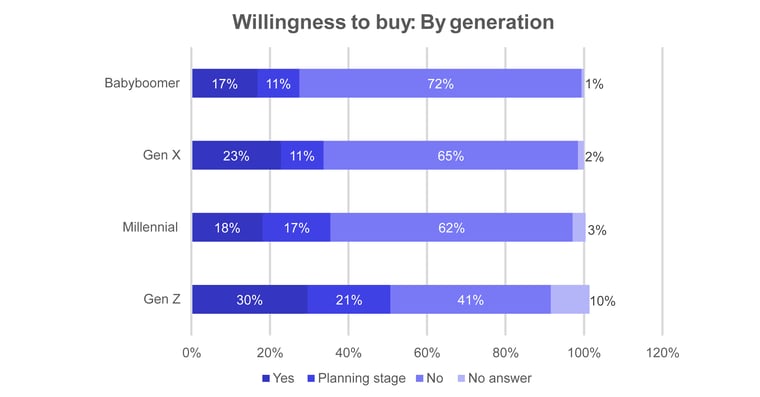
Win the loyalty of customers with pet health insurance
It is estimated that there were around 34.9 million (registered) pets in Germany in 2020. Last year, 47 percent and consequently almost half of German households had at least one pet. This includes about 11 million dogs. The number of dogs and cats in particular has risen sharply in the past year. Due to the Corona pandemic, many animal lovers suddenly had enough time to give a cat or dog a new home. Not surprisingly, the German pet market is one of the largest sales markets in Europe, as a study from 2020 shows.
Pet health insurance: a market with great potential
What is surprising, on the one hand, is that the market for animal health insurance is still underdeveloped in Germany. If you compare it with other countries, there is still a lot of catching up to do and great potential for further development. In general, German pet owners spend around 10 billion euros a year on their pets - but only 230 million euros of that amount is spent on pet health insurance. On the other hand, only 10 providers are currently active in the German market - a unique opportunity to enter now an almost competition-free insurance segment.
Veterinary treatments can quickly reach a four-digit amount per year and special pet health insurances are the only way to cover the costs of possible treatments and operations. Many new pet owners are therefore faced with the question of what happens if my pet becomes ill or – in the worst case – requires surgery? What will preventive care, dental treatment or vaccination cost me? What if I can't afford this procedure? This emotional component plays an important role in choosing the right pet health insurance.
After pet ownership experienced a real boom in Germany last year, more and more owners are thinking about the appropriate cover. This also means that advice on pet health insurance from an insurer, broker and the vet should soon be standard. A study from 2020 came to the conclusion that the majority of German veterinarians are also clearly in favour of comprehensive pet insurance or at least surgery cover.
A clear trend is already emerging, with new pet health insurance policies more than doubling last year compared to 2019, an increase of 130 percent in new contracts compared to the previous year. Experts even predict a sixteen percent annual growth for the German market until 2030.
Millennials and baby boomers give everything for their dogs
Two of the most important target groups are millennials and baby boomers. Millennials, now 25 to 44 years old, are often underinsured and currently do not pay much attention to insurance. Almost 35 percent of all pet owners are in the Millennial group, and it is precisely in this target group that the number of pet owners continues to increase. There are many reasons for this, but especially in the larger cities, a dog fits in well with the current work and life situation of Millennials. Today, a dog can often be taken to the office, where it also creates a good mood among work colleagues. Due to the change in the working environment and the possibility of working from the home office, animal welfare is also taken care of, and the lunch break is spent together in the fresh air. International studies show that millennials are open to an emotional appeal about pet insurance products and can be nominated as a target group for the product.
In contrast, there are the baby boomers, the parents' generation of the Millennials. Usually, this group has a high willingness to deal with insurance. They attach meticulous importance to being insured in the best possible way. Again, the emotional appeal of pet health insurance is a promising approach. After all, many 50- to 65-year-olds get a four-legged companion after their children have left home. Currently, more than 25 percent of all pet owners in Germany are over 60 years old and their number is increasing.
Pet health insurance can be linked to other issues, especially for this generation, since a dog can contribute significantly to emotional well-being and mobility in old age. In addition, a completely digital pet health insurance offers the possibility to offer a compact product at a good price for long-term existing customers. Dynamic pricing in real time makes this possible even today. Pet health insurance can thus increase customer loyalty.
Advice, additional insurance modules, big brand name? What dog owners look for in an insurance policy
To further investigate this exciting market segment, ELEMENT commissioned the research institute YouGov to conduct a survey. 2029 participants were surveyed, representative of the population according to age (18+), gender and region.
The most important finding first: 34 percent would like to insure their future pet. 37 percent have not yet decided and only just under a quarter (24%) do not want to take out a pet health insurance. Therefore, decisive factor is informing people about the advantages of insurance for the new family member. The willingness is even higher in the age group 18–24-year-old persons, the so-called "Gen Z". One in three has already taken out pet insurance and as many as 21 percent plan to do so for their pet. Regardless of this, every age group wants additional modules to make their insurance individual and according to their own requirements.

What criteria do the target groups consider selecting their future insurance provider? For most, the utmost important point: quality and scope of benefits. This is followed immediately by insurance costs. Surprisingly, awareness and image of the insurance provider plays only a subordinate role for more than two thirds of the respondents (67%) - an argument for entering the pet insurance market with a white-label solution from ELEMENT. If the policyholder feels well advised and looked after, every second pet owner (52%) is also prepared to pay more for the insurance.
Animal health insurance is a growing market segment
The survey thus shows one thing above all: Gen Z and millennials are the important target group in the rapidly developing market for animal health insurance. Insurance providers who pay attention to these target groups can best reach them with tailor-made products and consequently establish a long-term relationship. The Corona pandemic has increased the desire of many people to have a pet of their own. If you take this increasing demand for four-legged companions and the still very small German market in animal protection insurance, now is the time to bring this still underestimated product segment to the forefront.
That is why ELEMENT has developed various white-label insurance solutions around the topic of pets. We have recognised that brands can only connect with pet owners if the insurance product offered is designed in the "look and feel" of the provider. We also know that pet health insurance is not easy to develop. Especially in the area of dog owner liability and dog health insurance, because the many risk profiles of the individual dog breeds (around 350 in number) and the continuous developments in veterinary medicine have to be taken into account. In addition, there is usually a high number of claims notifications, which can only be managed through agile and completely digital processes.
With our solutions, we enable both companies from outside the insurance industry and insurers to integrate animal protection products into their own portfolios within a very short timeframe. Thanks to our BaFin licence as a primary insurer, these solutions are of course also available to MGAs, intermediaries, and brokers. The sales partner is always the customer's first point of contact.
All points of contact are designed in the brand of the sales partner. ELEMENT, as an independent risk carrier, works exclusively as a supplier and always remains in the background. This allows companies to offer their customers high-class animal welfare products that can be flexibly modified to their needs without much effort. It has never been easier to secure market share in this future market and at the same time expand one's own product portfolio to further strengthen customer loyalty.

